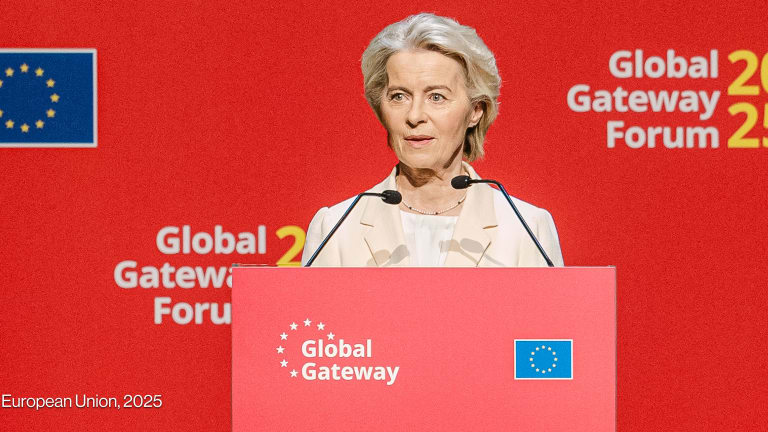
The European Union’s development chief says national governments need to put up more money to make the debut of Europe’s answer to the Chinese Belt and Road Initiative a success.
“It's not the team without team members,” Jutta Urpilainen, EU commissioner for international partnerships, said in an interview with Devex this week. “In order to really have a ‘Team Europe’ initiative, we need to have coordination, but we also need to get financial contributions from the member states.”
Inside the latest Europe-Africa summit deliverables
A plan to rely more on the EU's own border agency in Africa is among those raising alarm.
The European Commission aims to use next week’s summit between leaders from the EU and African Union to showcase its Global Gateway scheme, intended to mobilize up to €300 billion of investment abroad, with a focus on green and digital infrastructure. To reach that projected figure, however, Urpilainen said the commission needs EU states to supplement Brussels’ financing.
Koen Doens, the head of the international partnerships department at the commission, has been meeting with the development heads from EU national bureaucracies for more than a year to assemble a list of joint priorities — so-called Team Europe initiatives, or TEIs — covering support to small businesses, energy, migration, health, and more.
There are now around 150 TEIs in various stages of completion, and a handful of “flagships” will feature in an investment package to be unveiled at next week’s summit.
Amid tension over African calls for an intellectual property waiver for COVID-19 vaccines and doubts over European support for natural gas on the continent, the overall financing will also be closely watched as a test of whether the EU’s proposed new partnership with Africa goes beyond the usual warm words. Last month, Senegalese President Macky Sall called for a significant investment package.
Doens wrote to officials from EU countries in mid-January, underlining the “crucial” point that of the €20 billion in grants that Europe provides to Africa each year, €6.4 billion comes from the commission and €13.6 billion from member states bilaterally. “In other words: if we only look at Flagship TEI from the perspective of EU funding, we are only showcasing 1/3 of what Team Europe represents,” Doens wrote.
That was followed by an email last week, saying that “over the past weeks, the level of political commitment in Member States on these flagships has been mixed.”
Doens wrote that “Whilst some of them have mustered strong political commitment, such as those related to human capital (health and education), others have not gathered such support yet.”
He added, “That is notably the case of proposed flagships related to infrastructure in energy, digital and transport, three priority investment areas of Global Gateway and of strategic importance to our African partners.”
The latest draft investment package, to be discussed by EU states in Brussels on Friday, states that future funding commitments “are not yet determined and depend on Member States’ yearly national budgetary processes.”
But synchronizing budgets is not the only snag.
“To really have a ‘Team Europe’ initiative, we need to have coordination, but we also need to get financial contributions from the member states.”
— Jutta Urpilainen, EU commissioner for international partnershipsDiplomats told Devex that other factors affecting member states’ support included the varying state of readiness of the plans, preexisting member state presence on the ground, the higher amount of promotion for some initiatives, and some donors’ lack of experience with infrastructure investments, as well as the complexity of multicountry regional TEIs and how to govern them.
The TEIs have always been a balancing act between EU countries’ existing priorities, the commission’s desire to better steer the bloc’s overall development efforts, and their common interest in Europe being more visible in Africa.
Urpilainen told member states in January that the commission had estimated TEIs would account for 62% of partner country programs under the commission’s 2021-2027 budget.
“It’s a good thing for most of the money to be programmed geographically, as long as priorities, projects, investments are jointly agreed on and jointly owned with partner countries,” said Mikaela Gavas, a co-director of the Europe program and senior policy fellow at the Center for Global Development. However, “we don’t have any idea of how agreeing the TEIs have worked in practice and whether partner countries have genuinely been involved,” she told Devex this week.
Doens told Devex Thursday that local ownership had been achieved by discussing TEIs during the recently concluded budgetary programming process with partner countries. As for concrete financial contributions from member states, Doens said these would come at different times depending on the startup costs of each initiative — and not necessarily in time for the Feb. 17-18 summit with the AU.
Urpilainen also defended the Global Gateway against a charge by The Economist that it is largely a “bullshit” repackaging of already-agreed funds.
“Personally, I'm very proud of it — and it's not ‘bullshit,’ definitely not,” said the former Finnish finance minister, portraying it as the natural extension of the commission’s focus on green and digital issues inside the EU.
As for Team Europe, “I really hope that that could be one of our legacies,” she said, adding that it could be “something permanent, and not only in the field of international partnerships, but more in general, that we could really work as a team so that the member states and the commission but also [international financial institutions] would really, at the country level, define that these are our policy priorities and these we are going to co-finance and coordinate together.”








